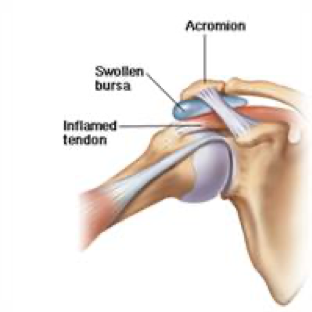With the fall season already upon us, many of us are starting back up our recreational/competitive sports, finishing up yard work before the winter season, or completing home renovations while the weather is still warm(ish). Often times, many of these activities require repetitive overhead motion of our shoulders. Over time, these repetitive movements can lead to over-use injuries of the shoulder, where eventually simply reaching up to put your purse in the closet or performing a movement you have done hundreds of times becomes painful. One of the reasons for your pain in your shoulder may be due to an inflamed bursa, called bursitis.
So you may be thinking, I’ve recently been diagnosed, but what is it and how did I develop it? To understand what bursitis is, we first have to discuss what a bursa is. A bursa is a sack of fluid found in different parts of the body that help reduce friction between tendons, muscles, skin and bones. Bursitis is the term used if the bursa has become inflamed due to irritation. Common areas where bursitis is found in the body are in the shoulder, hip, elbow, and feet.
There are a variety of reasons that an individual may develop bursitis, and although over-use injuries are often the most common, there may be other reasons as to why you may have developed pain in your shoulder. Some of those issues include:
- Direct trauma to the bursa
- Muscular imbalances including weakness or motor control dysfunctions causing shoulder impingement
- Decreased muscle flexibility or joint mobility
- Anatomical/structural variations
- Joint disorders such as osteoarthritis, rheumatoid arthritis or psoriasis
If you have recently been diagnosed with shoulder (subacromial, subdeltoid, subcoracoid) bursitis, contact us at EQ Physio, where we have developed a specialized program (Freedom to Move Bursitis Program) to help you recover from your bursitis and get you back to moving pain-free.

Simon Janik, Registered Physiotherapist, is a graduate of Western University. He has taken post-graduate courses in manual therapy acupuncture and has a special interest in working with athletes, having been a former NCAA tennis player.
Source:
Figure 1: https://physioworks.com.au/injuries-conditions-1/bursitis_shoulder

